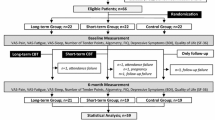Abstract
Since 1982, a total of 88 patients with refractory fibrositis have received treatment as part of an integrated group program within a psychiatric outpatient clinic working closely with the department of rheumatology. The best arrangement proved to be a series of 15 weekly two-hour sessions with groups of 8 patients. The program has three main elements: information, instruction in pain control strategies, and group discussion. The pain control strategies taught are cognitive behavioral techniques, relaxation, and exercises. A controlled study with 27 patients demonstrated that a comprehensive program of this kind was superior to instruction in autogenic training alone. Patient feedback confirmed the importance of the information given and of the group discussions; it is helpful to offer patients a wide range of pain control strategies that they can apply themselves. Our program makes it possible for a greater proportion of patients to learn one or more techniques affording some measure of pain relief. It is important for the therapists to adopt a positive and convincing attitude while restricting themselves to helping the patients to help themselves and avoiding power struggles. They should also be ready to accept the patients and their view of the illness, and not attempt to interpret the illness as the expression of something else.
Zusammenfassung
Das Konzept einer ambulanten Gruppenbehandlung für Patienten mit therapieresistenten, weichteilrheumatischen Beschwerden (Fibrositis-Syndrom) wird dargestellt. Das Behandlungsprogramm setzt sich aus den 3 Hauptelementen Information, Aussprache und Instruktion in Selbsthilfestrategien zusammen. Für die Selbsthilfe werden verschiedene Entspannungstechniken (u.a. Autogenes Training), kognitiv-verhaltenstherapeutische Schmerzkontroll-Techniken und Gymnastikübungen vermittelt. In einer kontrollierten Studie mit 27 Patienten konnte gezeigt werden, daß ein solches umfassendes Programm der reinen Vermittlung von Autogenem Training überlegen ist. Die Rückmeldungen der Patienten bestätigen, daß diese vor allem die Informationen und die Aussprachemöglichkeiten sehr schätzen. Ebenso werden die wichtigsten Elemente der therapeutischen Grundhaltung dargestellt: Indem die Therapeuten sich auf die Hilfe zur Selbsthilfe beschränken, können sie therapeutische Machtkämpfe vermeiden. Jedoch müssen sie bereit sein, die Patienten bedingungslos mit ihrer Sicht des Leidens zu akzeptieren, statt zu versuchen, es als Ausdruck von etwas anderem umzudeuten.
Similar content being viewed by others
Literatur
Baptiste S, Herman E (1982) Group therapy: a specific model. In: Roy R, Tunks E (eds) Chronic pain, Williams & Wilkins, Baltimore
Beck D (1977) Das Koryphäen-Killer-Syndrom. Dtsch Med Wochenschr 102:303.
Berne E (1967) Spiele der Erwachsenen. Rowohlt, Reinbeck. (Englischer Orginaltitel: Games people play, Grove, New York, 1964)
Bernstein DA, Borkovec TD (1975) Entspannungstraining. Handbuch der Progressiven Muskelentspannung, Pfeiffer, München
Cziske R, Jäckel W, Jacobi E (1987) Probleme bei der Durchführung eines Schmerzbewältigungsprogrammes bei Rheumapatienten und Untersuchungen zu seiner Effektivität Z Rheumatol 46:328
Fordyce WE, Steger JC (1982) Chronischer Schmerz. In: Keeser W, Pöppel E, Mitterhusen P (Hrsg) Schmerz. Urban & Schwarzenberg, München
Frank JD, et al. (1978) Effective ingredients of successful psychotherapy. Brunner/Mazel, New York
Haley J (1978) Gemeinsamer Nenner Interaktion. Pfeiffer, München
Literatur gestrichen
Keel PJ, Bally F, Cueni S (im Druck) Psychosoziale Aspekte in der Beurteilung und Behandlung therapieresistenter Rückenschmerzen. In: Chronischer Schmerz und Psyche. Schmerzstudien, Bd 8. G. Fischer. Stuttgart
Melzack R, Wall PD (1965) Pain mechanisms: a new theory. Science 150:971
Müller-Hegemann D (1981) Autogene Psychotherapie. Rowohlt, Reinbeck
Rehfisch HP, Basler HD, Seemann H (1989) Psychologische Schmerzbehandlung bei Rheuma. Springer, Berlin Heidelberg New York
Sternbach RA (1974) Pain patients. Academic Press, New York
Watzlawick P, Beavin JH, Jackson DD (1969) Menschliche Kommunikation, Formen, Störungen, Paradoxien Huber, Bern
Zimmermann M, Handwerker HO (1984) Schmerz. Konzepte und ärztliches Handeln, Springer, Berlin Heidelberg New York
Author information
Authors and Affiliations
Rights and permissions
About this article
Cite this article
Keel, P.J. Sechs Jahre Erfahrung mit ambulanter Gruppenbehandlung für Weichteilrheumatiker. Schmerz 4, 88–95 (1990). https://doi.org/10.1007/BF02527840
Issue Date:
DOI: https://doi.org/10.1007/BF02527840




